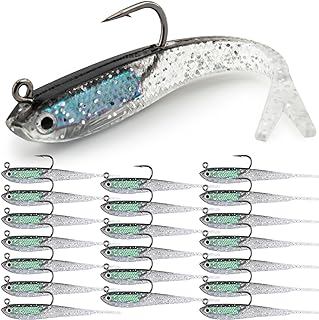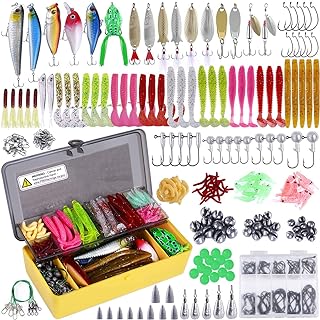5 important factors worth considering when looking for the best bass lure
When you’re bass fishing, choosing the right lure is super important. There are a lot of options, like topwater lures and jigs, and each is good for different situations. In this article, we’ll help you figure out the key things to consider when picking the best bass lure for you. We want to give you the information you need to improve your fishing and have more fun.
See our guide to the best bass lure.
Type of lure (crankbait, spinnerbait, jig, etc.)
Choosing the right lure for bass fishing can be difficult because there are so many options available. Each type of lure, like a crankbait, spinnerbait, or jig, has its own benefits and challenges when used in the water. From my experience, the crankbait is the best choice for covering a large area efficiently when fishing for bass. It can dive to different depths, move like real baitfish, and attract bass to strike with aggression.
Spinnerbaits are also effective, especially in dark or low-light conditions when bass rely on their senses to find prey. The movement and shine of spinnerbaits can lure bass from far away, making them a top choice for anglers targeting big bass in tough situations. On the other hand, jigs are great for enticing bass in thick cover or when a subtle approach is needed. By imitating crawfish or other creatures on the bottom, jigs can make even the pickiest bass react.
Ultimately, successful bass fishing depends on understanding the conditions and behavior of the fish in a specific environment. By choosing the right lure for the situation, anglers can increase their chances of catching bass.
Size and weight of the lure
When you’re choosing a bass lure, the size and weight are important for your success. Think about what bass usually eat where you’re fishing, and pick a lure that is similar in size. A bigger lure can look more like a big meal, which can attract larger bass. Lighter lures can work well in shallow waters or when bass are eating smaller fish or insects. By matching the size and weight of your lure to the bass’s feeding habits, you can improve your chances of catching fish.
The size and weight of your lure can also affect how it moves in the water, which can attract bass to bite. Heavier lures can be cast farther and sink faster, letting you cover more water and reach deeper areas where bass hide. Lighter lures are good for subtle fishing in clear or shallow water. By trying out different sizes and weights of lures, you can find the best one to use in different situations. Understanding the importance of your lure’s size and weight is key to becoming a better bass fisher.
Color and design of the lure
When picking the right color and design for your bass lure, it’s important to think about the fish you’re trying to catch. Bass have good eyesight and are predators, so using colors that look like what they normally eat can help you catch more fish. Colors like green, brown, and black can mimic things bass like to eat, such as crayfish and small fish. It’s also important to think about how clear the water is and how bright the light is when choosing your lure.
Using traditional colors can be a good idea, but trying something new can also be successful. Bass are curious and might be interested in something different. Bright colors like chartreuse, orange, and pink can work well in dark or murky water because they stand out. It’s helpful to be flexible and change your color choices based on where you’re fishing. Understanding how color affects bass can help you catch more fish and maybe even snag a big one.
Action and movement of the lure
When choosing the right bass lure, it’s important to focus on how it moves in the water. The way a lure moves can either attract or deter bass from biting. Lures that move realistically can mimic the behavior of prey, triggering bass to strike. Anglers should consider the design and construction of the lure to ensure it moves smoothly and mimics baitfish in the bass’s habitat.
In bass fishing, a lure’s effectiveness depends on its ability to look and act like real prey to catch the attention of bass. Lures with irregular movements, gentle vibrations, or lifelike wobbling can be very appealing to bass, even the most cautious ones. By using high-quality lures with great movement, anglers can increase their chances of catching a big bass. Remember, in bass fishing, it’s not just about the appearance of the lure, but also how it moves that matters the most.
Water conditions and depth of fishing spot
When choosing the right lure for bass fishing, it’s important to think about the water conditions and how deep the fishing area is. These factors can make a big difference in how successful your fishing trip will be. Matching the color, size, and movement of your lure to the clarity of the water and its depth can help you catch more bass. In clear water, use natural colors and subtle movements to blend in with the surroundings. In murky water, bright colors can attract bass hiding in the shadows.
It’s also helpful to pay attention to how deep the fishing spot is when deciding which lure to use. Different lures are made to fish at different depths, such as topwater lures for the surface or deep-diving crankbaits for lower levels. By picking a lure that reaches the depth of the water, you can target bass at their level and have a better chance of catching them. Considering both water conditions and depth of the fishing spot can improve your fishing trip and make it more successful.
Conclusion
Choosing the right bass lure is a personal process that combines skill, experience, and understanding of the environment. Debates may continue about the best lure design or color, but a angler’s passion and intuition determine success. Bass fishing is more than a hobby—it’s a lifelong connection to nature. Remember, the perfect bass lure is not just a tool, but part of your fishing journey. Want more info on paint edger tool for corner, check the best paint edger tool for corner.

